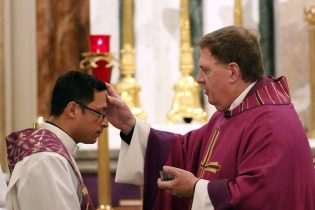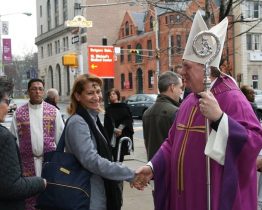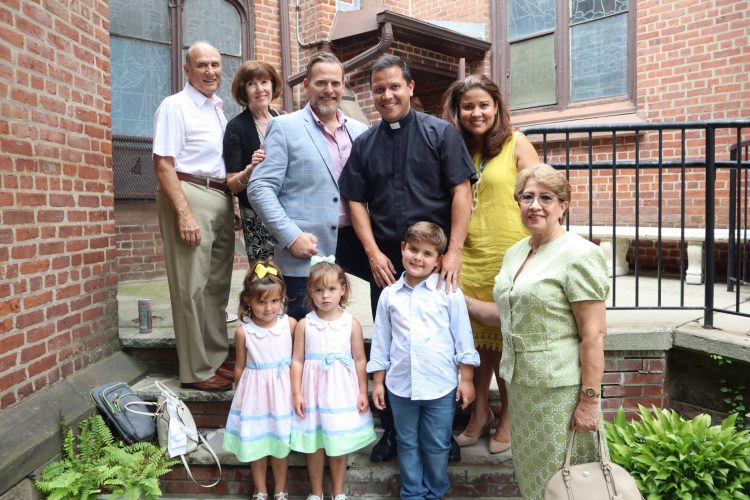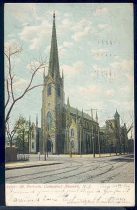The year 2000, beginning a new century and a new millennium, was a year of joy and expectation. The newly renovated pro-cathedral observed its sesquicentennial, its 150th anniversary, with a Mass celebrated by the archbishop. Father Mahoney was elevated to the rank of prelate of honor with the title of Monsignor, an honor enjoyed by many of his predecessors.
Just over a year later, everything changed. On September 11, 2001, remembered as 9/11, terrorists hijacked and crashed planes into the World Trade Center in Manhattan. As the fires continued in the ruins, about ten miles away, a haze hovered over Newark. The haze was symbolic of a pall of sorrow that covered the United States. Many parishioners had loved ones or friends that perished in the attack.
At Saint Patrick’s, the number of Latino parishioners continued to increase. In addition to the long-standing Puerto Rican community, new parishioners from Santo Domingo (Dominican Republic), Ecuador, and other Latin American nations added to the community. Just as the Puerto Rican community contributed the statue of and devotion to Our Lady of Providence, the Ecuadorian community presented the pro-cathedral with a statue of its patron, Our Lady of Quinche. The statue of Our Lady of Quinche is representative of the Latin American style. Not a simple wood or plaster painted statue, it is adorned with beautiful hand-embroidered robes that are periodically changed. The women of the Ecuadorian community take great pride in producing these magnificent garments for their patroness. Each year there is a solemn procession of the statue through the neighborhood and beyond.
The parish remained small in numbers and finances always were an issue. Monsignor Mahoney produced income through the rental of various properties. The school had been leased to Catholic Charities and, when the lease expired, he leased it to a charter school for a larger amount, thereby keeping the parish finances stable.
More than 150 years earlier, Saint Patrick’s Parish was formed from Saint John’s Parish, the first Catholic parish in the city of Newark. St. John’s, like St. Patrick’s now had fewer parishioners than in years before. On July 1, 2005, Archbishop Myers “linked” the two parishes. Naming Monsignor Mahoney pastor of Saint John’s in addition to Saint Patrick’s. While there were very few parishioners in Saint John’s, it was distinguished for its long-term dedication to the disadvantaged through the maintenance of a soup kitchen that drew hundreds of the poor every day. During the pastorate of Monsignor John Hourihan (1977-1997), it became a center for the Deaf Apostolate in the archdiocese of Newark. For many years, a Mass was celebrated for deaf congregants in sign language. This was a fortuitous connection since Monsignor Mahoney had learned sign language and often had celebrated this Mass. In 2008, newly ordained Father Pedro Bismarck Chau, fluent in sign language, initiated a weekly Mass for the deaf at Saint John’s. The linking of the two parishes also provided an opportunity to consolidate the administrative offices of the two parishes. All of the parish offices moved to Saint John’s, producing significant savings.
Additional adjustments came with the leasing of the rectory to the archdiocese of Newark as a home for Emmaus House, a house of discernment for future seminarians, and for the Newman Center, the apostolate to the nearby campuses of Rutgers, NJIT, and Essex Community Colleges. The first floor of the convent, which had housed the offices of St. Patrick’s, was reconfigured into an apartment for Monsignor Mahoney. Four sisters continued to rent the second and third floors of the convent.
Several Spanish-speaking priests who celebrated the Sunday Mass in Spanish addressed the pastoral care of the growing Latino community. Often, they would stay for a few hours and address various pastoral concerns. However, there was frequent change and the necessary continuity for the people was not present. In 2013, Monsignor Mahoney asked Father Pedro Bismarck Chau, associate director of the archdiocesan Office of Youth and Young Adult Ministries, and resident in nearby Kearny, to come to Saint Patrick’s every week for the Spanish Mass and to build up religious education and adult ministries among the Latino community. Father Bismarck continued to celebrate the Deaf Mass in Saint John’s as well.
Transitions
Early in 2015, Monsignor Mahoney submitted his request for retirement to Archbishop Myers. To everyone’s joy, the archbishop appointed Father Bismarck, already a familiar face at both parishes, as administrator of Saint Patrick’s and Saint John’s. Monsignor Mahoney celebrated a farewell Mass on September 20, 2015, and Father Bismarck was installed as pastor of both parishes on February 7, 2016. In addition, Father Bismarck was appointed as chaplain to campus ministry at Rutgers, NJIT, and Essex Community College, while continuing his ministry with the Deaf Apostolate.
Father Bismarck immediately focused on religious education. Residing in the rectory, which no longer accommodated Emmaus House, he transformed the first floor of the convent into several classrooms for religious education. He initiated an RCIA program and began to improve the liturgical celebrations by organizing a music ministry, at the same time coordinating and training altar servers and Eucharistic ministers. The custom of the Latino parishioners to have a social hour after Mass was adopted by the English-speaking community on a monthly basis. Father Bismarck moved all Sunday Masses from the chapel into the main church, allowing the magnificent organ once again to enhance the worship experience. The presence of nearby colleges and universities has brought about the involvement of university students in parish life and worship.
The chapel was rearranged allowing the statue of Our Lady of Quinche to be placed in the apse, becoming an even greater focus of devotion. Tables were added so that the chapel could be used for many different functions including evening retreats and dinners.
In August 2016, Archbishop Myers reached the age of 75 and submitted his letter requesting retirement to Pope Francis. On November 7, 2016, Pope Francis appointed Cardinal Joseph W. Tobin, C.Ss.R., Archbishop of Indianapolis, as Archbishop Myers’ successor. Cardinal Tobin was installed as archbishop of Newark on January 6, 2017.
Following the tradition established by his predecessors, Cardinal Tobin celebrated Ash Wednesday Mass in the pro-cathedral. It was a unique moment in the life of this venerable church. John Jelliff’s spectacular throne for the first time was adorned with a coat of arms of an archbishop of Newark bearing the scarlet hat of a cardinal.

Cardinal Tobin imposes ashes on Father Bismarck
As recognition of the growth of Saint Patrick’s and Saint John’s and their ministries, in June 2017, Cardinal Tobin appointed Rev. Juan Alexander Ortega Ortiz as parochial vicar of Saint Patrick’s and Saint John’s. For the first time in a quarter century, the parishes had a parochial vicar, a sure sign of the cardinal’s faith in the future of the parishes.
To communicate better in the technological age, the parish utilizes Facebook, Twitter, and other forms of social media. A parish website serves to provide up-to date information on parish activities. Older forms of communication are not ignored as a multi-page, bi-lingual weekly bulletin keeps parishioners informed of parish activities and events in the archdiocese.

The city of Newark is changing, and Saint Patrick’s and Saint John’s are changing with it. A new Prudential office building has arisen two blocks from the pro-cathedral. The long-abandoned Hahne’s department store, three blocks away, has been transformed into apartments, retail stores, and a restaurant. A large apartment complex has been built between Saint John’s Church and the New Jersey Performing Arts Center. Additional development in the neighborhood is under way and more is planned. Saint Patrick’s and Saint John’s will be significant participants in the future of the Catholic Church in Newark as they were in its past.
2020
The people of St. Patrick’s, resembling an ever-changing mosaic, gradually were increasing in number and moving forward with the new century and the new millennium.
No one could have predicted the traumatic changes that an invisible mystery virus, called the coronavirus, would bring about. Suddenly, the churches throughout the United States and the entire world closed. Immediately Father Bismarck arranged to livestream Mass in English and Spanish on YouTube and Facebook. He also provided scripture study and other services livestream. Father Juan was surprised to discover that his family in Colombia followed the Sunday Mass he celebrated on livestream thousands of miles away rather than their local church. Eventually, the regulations were mitigated, and small numbers of Catholics were admitted to the church for Mass again. While the pro-cathedral was closed or its opening limited, the parish’s website showed that the parish was not closed!
Even in the midst of the turmoil of the coronavirus, more surprises would come. In June, Cardinal Tobin called on Father Bismarck to move from the “old cathedral” to the “new cathedral” as rector of the Cathedral Basilica of the Sacred Heart. This probably is the first time that one priest successively has served as pastor of two cathedrals in the same city.
Cardinal Tobin showed the depths of his pastoral care for the pro-cathedral. He named another serious and energetic young priest, Rev. Camilo Cruz Bahamon, as administrator of Saint Patrick’s Pro-Cathedral and Saint John’s Parish. The transition took place on August 1, 2020.

Our new pastor, Father Camilo Cruz, a native of Colombia, was ordained 2010. He comes to Newark from Saint Peter’s Parish in River Edge. Father Cruz has extensive parochial experience and also holds several advanced degrees, Master of Divinity and Master of Arts from Seton Hall University and a Master of Science in Psychology degree from Fordham University.
More than any other church, Saint Patrick’s Pro-Cathedral symbolizes the continuity of the Roman Catholic presence in the City of Newark. It was dedicated three years before the Diocese of Newark was established. It served for a century as the seat of the Bishops and Archbishops of Newark. For more than a half century it has shared that distinction with the Cathedral Basilica of the Sacred Heart. For almost 175 years it has served the Catholic people of its immediate neighborhood and beyond. Its doors and the arms of its priests and people have welcomed the needy of all faiths and no faith at all. For the City of Newark, it has been a beacon of stability in the midst of change. Its priests and parishioners have never wavered in their dedication to the welfare of the city as a whole. Saint Patrick’s is married to the City of Newark, a marriage that has endured “in good times and in bad” and remains strong and healthy today.

St. Patrick’s Pro-Cathedral and the City of Newark have entered the twenty-first century with confidence in God, with Whose help all things are possible.
For information and picture galleries of St. Patrick’s Pro-Cathedral today, go to https://stppcnewark.com/
For information on St. John’s Church and St. John’s Soup Kitchen, go to http://www.njsoupkitchen.org/
« Parish Life As A New Millennium Dawned | Bishops and Archbishops of Newark, Priests of St. Patrick's Pro-Cathedral, Vocations to the Priesthood and Religious Life »
